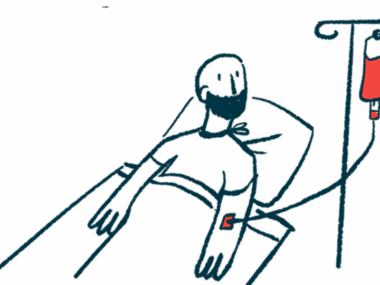Ultomiris successfully treats woman with thymoma-associated MG: Case
Treatment before, after thymus surgery managed condition for patient, 39
Written by |

A 39-year-old woman with severe myasthenia gravis (MG) associated with a thymoma, a thymus tumor, responded favorably to treatment with Ultomiris (ravulizumab), according to a case study from clinicians in Greece.
The treatment successfully managed the woman’s rapidly evolving symptoms in the acute setting. The patient later underwent surgery to remove the thymus gland and continued on maintenance treatment with Ultomiris, with dosing every eight weeks.
Supplementary doses of Ultomiris, together with intravenous immunoglobulin (IVIg) therapy, were used to manage episodes of symptom worsening between maintenance doses, per the report.
“Novel immunotherapies … have changed the therapeutic landscape of MG” in recent years, the researchers noted. However, “the role of these immunotherapies in the management of [thymoma-associated MG] has not been studied,” they wrote.
Here, “[Ultomiris] had an early and sustained clinical effect which contributed to the avoidance of intubation,” the researchers wrote.
The woman’s case was described in “Thymoma Associated Myasthenia Gravis Successfully Treated With Ravulizumab,” which was published in the journal Muscle & Nerve as a Letter to the Editor.
Scant data exist on use of novel immunotherapies in thymoma-associated MG
MG is caused by self-reactive antibodies that target proteins at the neuromuscular junction — the site of communication between nerve and muscle cells. Most commonly, these antibodies target acetylcholine receptors (AChRs) in muscle cells. The disease’s main symptoms include muscle weakness and fatigue.
Abnormalities in the thymus — a gland that’s part of the immune system — are commonly seen in MG patients, with thymoma being present in as many as 20% of all cases. Although new immunotherapies, including Ultomiris, have contributed to better managing the condition, their effects on thymoma-associated MG have not been studied.
Now, a team from the Greece Eginitio Hospital in Athens described the case of a middle-aged woman with a one-month history of severe and rapidly progressive generalized muscle weakness. Her symptoms affect the bulbar, or head and neck muscles, as well as eye, respiratory, trunk, and limb muscles.
Further evaluation indicated that the woman had elevated levels of anti-AChR antibodies, and a CT scan revealed the presence of a thymoma.
At diagnosis, she was classified as class IIIb according to the MG Foundation of America (MGFA), corresponding to moderate muscle weakness in several muscle groups, especially those in the mouth and throat, and those involved in breathing. She also had a score of 8 on the MG Activities of Daily Living (MG-ADL), a standard measure of MG severity and impact on daily functioning, in which higher scores indicate more severe impairment. Scores on the MG-ADL range from 0 to 24.
Initial treatment with corticosteroids, plasma exchange, known as plasmapheresis, and IVIg was ineffective at controlling her symptoms. When the patient was admitted to the hospital, her condition worsened to severe muscle weakness (MGFA class IVb), an MG-ADL score of 21, and a score of 29 — of a maximum of 39 — on the Quantitative MG (QMG) scale, another standard measure of MG severity.
Ultomiris use helped lead to ‘patient’s favorable outcome,’ per report
At this point, the woman had a complete eyelid drop in one eye, and difficulty speaking, swallowing, and breathing. She required a nasogastric tube for feeding and was transferred to the intensive care unit due to an impending myasthenic crisis, or severe breathing problems.
“We decided to introduce [Ultomiris],” the researchers wrote.
The patient was started on treatment, with a loading dose of 2,400 mg on the first day. Before starting the therapy, she received meningococcal vaccination and antibiotics to prevent infections.
Her breathing improved over the first days of treatment, and her nasogastric tube was removed on the seventh day. She received the first maintenance dose of Ultomiris (3,000 mg) and was discharged from intensive care on day 15.
Eight weeks, or about two months, later, her condition had significantly improved, with an MG-ADL score of 3 and a QMG score of 11, with residual weakness in limb and neck muscles. She then received the second maintenance dose of Ultomiris.
The role of [Ultomiris] in the acute setting of MG deserves consideration and certainly more data are needed to evaluate its effectiveness and safety in this condition.
Three and a half months after initiating treatment, she was given a supplementary 600 mg dose of Ultomiris and IVIg and underwent thymectomy, or surgery to remove her thymus gland.
One month after surgery, the woman received the third Ultomiris maintenance dose, and two weeks later she had an episode of disease worsening with weakness in the neck and upper limbs. She then received IVIg and a supplementary 600 mg dose of Ultomiris. Six weeks later, she received her fourth maintenance dose. The researchers ultimately noted “the patient’s favorable outcome.”
According to the team, “the role of [Ultomiris] in the acute setting of MG deserves consideration and certainly more data are needed to evaluate its effectiveness and safety in this condition.”








Leave a comment
Fill in the required fields to post. Your email address will not be published.